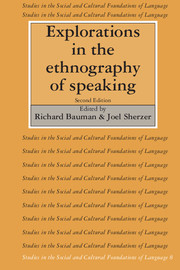Book contents
- Frontmatter
- Contents
- INTRODUCTION TO THE SECOND EDITION
- I PREFACE AND INTRODUCTION
- II COMMUNITIES AND RESOURCES FOR PERFORMANCE
- III COMMUNITY GROUND RULES FOR PERFORMANCE
- IV SPEECH ACTS, EVENTS, AND SITUATIONS
- V THE SHAPING OF ARTISTIC STRUCTURES IN PERFORMANCE
- Introduction
- 14 Correlates of Cree Narrative Performance
- 15 An Analysis of the Course of a Joke's Telling in Conversation
- 16 When Words Become Deeds: An Analysis of Three Iroquois Longhouse Speech Events
- 17 The Ethnographic Context of Some Traditional Mayan Speech Genres
- 18 To Speak with a Heated Heart: Chamula Canons of Style and Good Performance
- VI TOWARD AN ETHNOLOGY OF SPEAKING
- Notes
- References
- Index of names
17 - The Ethnographic Context of Some Traditional Mayan Speech Genres
Published online by Cambridge University Press: 05 June 2012
- Frontmatter
- Contents
- INTRODUCTION TO THE SECOND EDITION
- I PREFACE AND INTRODUCTION
- II COMMUNITIES AND RESOURCES FOR PERFORMANCE
- III COMMUNITY GROUND RULES FOR PERFORMANCE
- IV SPEECH ACTS, EVENTS, AND SITUATIONS
- V THE SHAPING OF ARTISTIC STRUCTURES IN PERFORMANCE
- Introduction
- 14 Correlates of Cree Narrative Performance
- 15 An Analysis of the Course of a Joke's Telling in Conversation
- 16 When Words Become Deeds: An Analysis of Three Iroquois Longhouse Speech Events
- 17 The Ethnographic Context of Some Traditional Mayan Speech Genres
- 18 To Speak with a Heated Heart: Chamula Canons of Style and Good Performance
- VI TOWARD AN ETHNOLOGY OF SPEAKING
- Notes
- References
- Index of names
Summary
It is a well documented fact that during the Colonial period, the Indians of Middle America often expressed their thoughts in semantic couplets (and occasionally, triplets). The largest corpus of such materials is in the Nahuatl language, but other languages such as Otomí, Quiché and Yucatec Maya are also represented. Garibay (1953) has documented the use of couplets by the Nahuas and Otomís of central Mexico. Edmonson (1971) has shown that the Popol Vuh, the sacred book of the Quiché Maya of highland Guatemala, is written in semantic couplets; so too are the Chilam Balam of Chumayel and the Ritual of the Bacabs, both of which are written in Yucatec Maya (Edmonson 1968).
The essence of such couplet poetry is that ideas are expressed in parallel form.
Sometimes a thought will be complemented or emphasized through the use of different metaphors which arouse the same intuitive feeling, or two phrases will present the same idea in opposite form … Another device used in lyric poetry, as well as in discourses and other forms of composition, consists of uniting two words which also complement each other, either because they are synonyms or because they evoke a third idea, usually a metaphor … Examples of this are the following: flower-and-song which metaphorically means poetry, art, and symbolism; skirt-and-blouse which implies woman in her sexual aspect; seat-and-mat which suggests the idea of authority and power; face-and-heart which means personality.
(León Portilla 1969:76–7)- Type
- Chapter
- Information
- Explorations in the Ethnography of Speaking , pp. 368 - 388Publisher: Cambridge University PressPrint publication year: 1989
- 3
- Cited by

